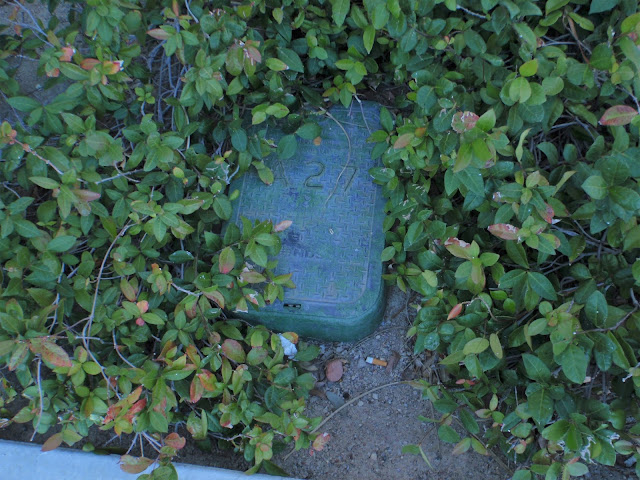This is the label information on Alco Olive Stop.
Please read what I copied from the EPA in 2012 on this label and I will give you a condensation of what it says at the very end. What I tell you here does not replace the information on the label. The label of any pesticide is the legal information provided by the Manufacturer and is the most recent information.
Label Information
For Ornamental Olive Flower and Fruit Elimination
For best results ALCO OLIVE STOP should be applied when the olive trees are in full bloom and
before fruit set has occurred. During periods of extended bloom more than one spray will be necessary
to achieve total flower elimination. When extended bloom occurs the first application should be made
between 1/2 and 3/4 bloom with a second spray made 7 to 14 days later. If necessary a third spray
may be made 7 to 14 days after the second application. In desert or extremely dry areas all fruit can
be eliminated even after fruit has reached pinhead to small shot size. However best results are
obtained when olive trees are sprayed during bloom prior to fruit set. Mix 4.0 fluid ounces of ALCO OLIVE STOP in 10 gallons of water. To ensure proper coverage add 1/2
to 1 fluid ounce of any suitable non ionic wetting agent to each 10 gallons of spray mix. ALCO OLIVE
STOP can be applied through any conventional spraying equipment. For broadcast use olive trees can be treated at rates up to 96 0 fluid ounces per acre per
treatment (up to 0.33 lb of 1 NAA equivalent). Do not exceed 96.0 fluid ounces (0.33 lb of NAA equivalent) ALCO OLIVE STOP per acre per season.
Rates for Ornamental Pear and Ornamental Plums
For Fruit Elimination in Ornamental Pears and Plums make a single application either at full bloom or during the period up to 5 days following full bloom. Apply to achieve full coverage. Mix 3.0 fluid ounces of ALCO OLIVE STOP in 10 gallons water. To ensure proper coverage add 1/2 to
1 fluid ounce of a suitable non ionic wetting agent to each 10 gallons of spray mix. Spray trees
thoroughly wetting all foliage. For broadcast use the maximum application rate must not exceed 32.0 fluid ounces per acre
per application (0.11 lb of NAA equivalent) for ornamental pears and plums. Do not apply
more than 96.0 fluid ounces per acre (0.33 lb of NAA equivalent) of ALCO OLIVE STOP per
season.
What the Label Says
These directions are only for Alco Olive Stop. The reason for this, other manufacturers have their own labels. The rate or amount of active ingredient may be more or less than Alco's.
Ingredient
The active ingredient that causes "abortion" of the fruit when it is very young is NAA (Naphthaleneacetic acid). It is absorbed into the flowers and leaves where it moves to the base of the ovaries and causes the ovaries and fruit to drop when very small. NAA is a synthetic hormone. It mimics naturally occurring plant hormones called auxins. It is used to abort fruit when they are very young, grow roots on cuttings (propagation), cause flowering to start when it might not, and keep fruit from falling off the tree when it might normally fall off. Olive Stop uses NAA for aborting the fruit when very young. This is the reason it is sprayed on trees when they are flowering. The spray concentration used to do this is very important.
Directions for Use
Determine the amount of water needed by spraying the tree with water before it begins flowering. Spray until water drips from the leaves all through the canopy to be sure all of the leaves (flowers) are wet. Write down how much water is needed for each tree. Wait for the tree to form most of its flowers and then immediately spray when there is no wind or less than 1 mph. Protect vital areas of your body when spraying by wearing washable rubber gloves, face protection, neck protection, long sleeves long pants, and waterproof shoes or boots. Shower and wash your clothes immediately after applications.
Sprayers
 |
| Solo backpack sprayer |
On the day the tree is in full bloom, put as much distilled or at least very clean water into the sprayer. When the sprayer is half full, add 0.3 fluid ounces of Olive Stop liquid for each gallon of water. At this time also add a surfactant (sticker/spreader) such as Grow More's EZ Wet, Hi Yields Spreader Sticker, Monterrey's Herbicide Helper or Bonide's Turbo Spreader Sticker. Finish filling the sprayer until the desired amount of finished spray is attained. When the spray is applied, the tree should be in full bloom, i.e., the majority of flowers are open. Spray the tree until the leaves start dripping water.
Hose End Sprayers
Select the spray setting closest to 0.3 fluid ounces of Olive Stop for each gallon of water sprayed. Pour enough of the concentrated Olive Stop into its tank to finish spraying all of the trees. Combine this concentrated Olive Stop mixture with enough spreader sticker to make to make a finished spray. For instance, if you are making three gallons of finished spray then add enough spreader sticker in its tank for three gallons. The amount to use per gallon will be on the label. Gently add the concentration to the spray tank so it is evenly mixed. Spray the tree when most of the flowers are open. Spray until the leaves begin dripping water.
Cleaning the Sprayer
If any spray remains when you are finished, spray the remaining on the ground over the largest area possible. All sprayers are "triple rinsed" as soon as you are finished. This means the sprayers are rinsed with clean water three times. The rinsate is spread on the ground over the largest area possible. The sprayers are put away after triple rinsing.








